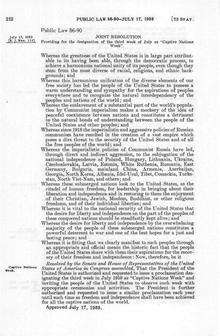Captive Nations Week

Captive Nations Week, a week aimed at raising public awareness of the oppression of nations under the control of Communist and other non-democratic governments, began in 1953 and was declared by a Congressional resolution and signed into law (Public Law 86-90) by President Dwight D. Eisenhower in 1959. President Eisenhower, and every successive U.S. President up to the administration of President Donald Trump, has declared the third week of July to be Captive Nations Week.
The American foreign policy expert George Kennan, serving at the time as ambassador to Yugoslavia, sought unsuccessfully to dissuade President John F. Kennedy from proclaiming the week on the ground that the United States had no reason to make the resolution, which in effect called for the overthrow of all the governments of Eastern Europe, a part of public policy.
Criticism
Russian emigres to the United States (specifically representatives of the Congress of Russian Americans) argued that the Captive Nations Week was anti-Russian rather than anti-Communist since the list of "captive nations" did not include Russians, thus implying that the blame for the oppression of nations lies on the Russian nation rather than on the Soviet regime (Dobriansky's Ukrainian nationalist views were seen as the reason for this).[1] Members of the Congress have campaigned for nullification of the Captive Nations law.[2]
Group of prominent American historians issued a statement claiming that PL 86-90 and the Captive Nations Week was largely based on misinformation and committed the United States to aiding ephemeral "nations" such as Cossackia and Idel-Ural.[3]
See also
References
- ↑ Tsygankov, Andrei (2009). Russophobia: Anti-Russian Lobby and American Foreign Policy. Palgrave MacMillan. ISBN 978-0-230-61418-5.
- ↑ Anatoly Bezkorovainy (2008). All Was Not Lost: Journey of a Russian Immigrant from Riga to Chicagoland. AuthorHouse.
- ↑ "A Statement on U.S. Public Law 86-90". Russian Review. 20 (1): 97–98. 1961. JSTOR 126589.
Bibliography
- Address of the Russian intellectuals to the Congress of the United States of America - Social Design Corporation. July 14, 2008.
- Fighting the 'Captive Nations Week Resolution' (Archived) - Congress of Russian Americans, Inc. 1999.
- Captive Nations Week, 2008 White House. 2008.
- Tim Weiner and Barbara Crossette. "George F. Kennan Dies at 101; Leading Strategist of Cold War". The New York Times. March 18, 2005.
- George F. Kennan: Cold War Iconoclast. Walter Hixson, 1988.